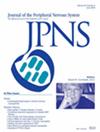揭示CMTX6的临床和电生理特征:来自两个巴西家族的见解。
IF 3.9
3区 医学
Q1 CLINICAL NEUROLOGY
引用次数: 0
摘要
背景和目的:6型X连锁Charcot-Marie Tooth病(CMTX6)是一种极为罕见的与PDK3基因突变有关的疾病。迄今为止,只报告了来自不同国家的三个家庭(澳大利亚、韩国和德国)。在这项研究中,我们试图提供两个巴西家庭的全面临床和电生理特征。方法:我们对先证者进行了全面的临床评估、广泛的电生理评估,并进行了全外显子组测序,以研究该疾病的遗传基础。结果:携带Arg162His突变的家族中的男性表现出早发性运动和/或感觉轴索神经病变,没有肌腱痉挛、空腔炎和经常报告的疼痛。同一家族的女性表现出较温和的疾病表型,发病较晚,一些女性在50多岁时仍无症状。在有一名患病男性的无关家族中,临床表现为严重的进行性感觉运动性多发性神经病伴神经性疼痛。解释:我们报道了两个患有CMTX6的巴西家族,其中一个家族在PDK3基因中携带一个先前未发表的变体,该变体与X连锁疾病中预期的疾病共分离。值得注意的是,包括我们的研究在内的五个有可用描述的家族的临床表现有着惊人的相似之处。此外,报告的三种突变的接近性表明了潜在的功能相似性和共同的潜在机制。这项研究有助于增加对CMTX6的了解,并强调了国际合作在研究罕见遗传疾病方面的重要性。这篇文章受版权保护。保留所有权利。本文章由计算机程序翻译,如有差异,请以英文原文为准。
Unveiling the clinical and electrophysiological profile of CMTX6: Insights from two Brazilian families
BACKGROUND AND AIMS
X-linked Charcot-Marie-Tooth disease type 6 (CMTX6) is an extremely rare condition associated with mutations in the PDK3 gene. To date, only three families from different countries have been reported (Australia, South Korea and Germany). In this study, we sought to provide a comprehensive clinical and electrophysiological characterization of two Brazilian families.
METHODS
We conducted comprehensive clinical assessments, extensive electrophysiological evaluations, and performed whole-exome sequencing in the probands to investigate the genetic basis of the disease.
RESULTS
Males in the family carrying the Arg162His mutation displayed early-onset motor and/or sensory axonal neuropathy, absence of tendon jerks, pes cavus, and frequently reported pain. Females in the same family exhibited a milder phenotype of the disease with later onset and some remained asymptomatic into their 50s. In the unrelated family with a single affected male, the clinical presentation was characterized by severe progressive sensorimotor polyneuropathy accompanied by neuropathic pain.
INTERPRETATION
We report two Brazilian families with CMTX6 including one harboring a previously unpublished variant in the PDK3 gene, which co-segregates with the disease as expected in a X-linked disease. Notably, the clinical presentations across the five families with available descriptions, including our study, share striking similarities. Furthermore, the proximity of the three reported mutations suggests potential functional similarities and common underlying mechanisms. This study contributes to the growing knowledge of CMTX6 and underscores the importance of international collaborations in studying rare genetic disorders. This article is protected by copyright. All rights reserved.
求助全文
通过发布文献求助,成功后即可免费获取论文全文。
去求助
来源期刊
CiteScore
6.10
自引率
7.90%
发文量
45
审稿时长
>12 weeks
期刊介绍:
The Journal of the Peripheral Nervous System is the official journal of the Peripheral Nerve Society. Founded in 1996, it is the scientific journal of choice for clinicians, clinical scientists and basic neuroscientists interested in all aspects of biology and clinical research of peripheral nervous system disorders.
The Journal of the Peripheral Nervous System is a peer-reviewed journal that publishes high quality articles on cell and molecular biology, genomics, neuropathic pain, clinical research, trials, and unique case reports on inherited and acquired peripheral neuropathies.
Original articles are organized according to the topic in one of four specific areas: Mechanisms of Disease, Genetics, Clinical Research, and Clinical Trials.
The journal also publishes regular review papers on hot topics and Special Issues on basic, clinical, or assembled research in the field of peripheral nervous system disorders. Authors interested in contributing a review-type article or a Special Issue should contact the Editorial Office to discuss the scope of the proposed article with the Editor-in-Chief.

 求助内容:
求助内容: 应助结果提醒方式:
应助结果提醒方式:


